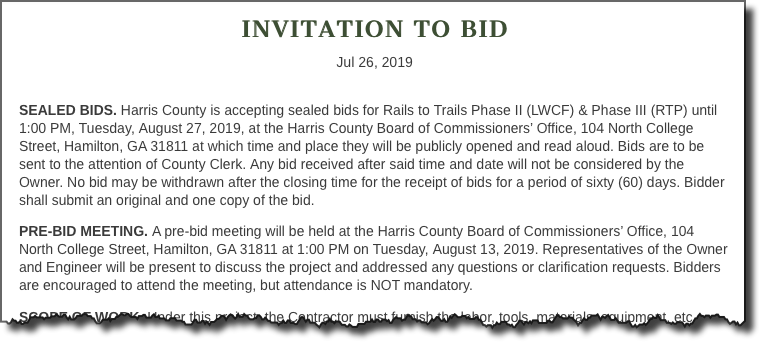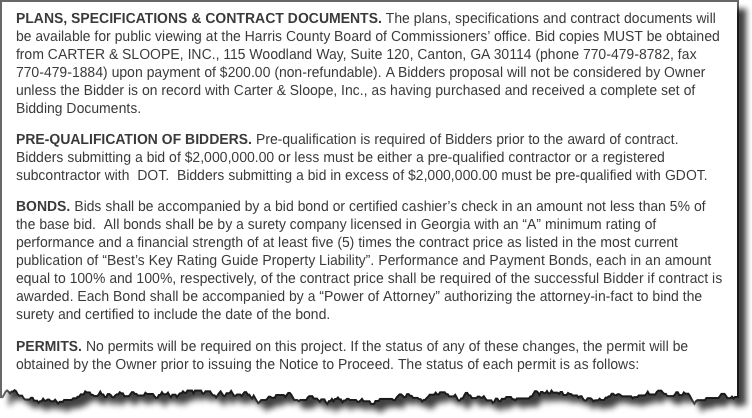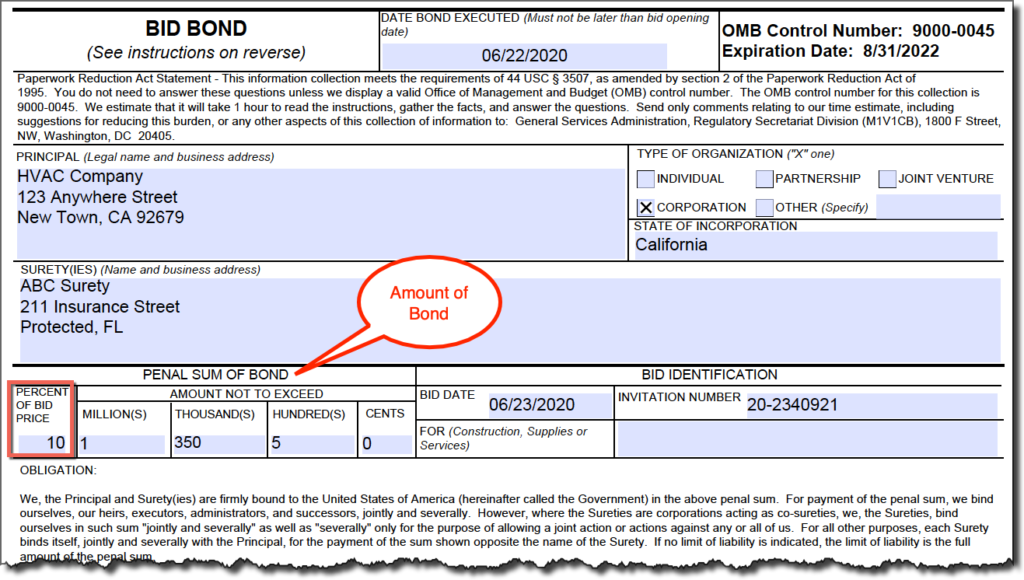The front end documentation is not contained within the CSI (Construction Specification Institute, Inc) MASTERFORMAT divisions (Division 22 – Plumbing, Division 23- HVAC, Division 26 – Electrical). We consider front-end documentation to be all the sections and information setout before division 1 of the specifications, including the RFP (request for Proposal), Instructions to Bidders, Supplemental Instructions to Bidders, or an Invitation to Bid.
This is the first place to begin an estimate. We will cover some of the information found in these sections, the RFP and Division 1 (General Requirements).
Invitation to Bid
The invitation to bid will provide you with most of the information you will need to make a decision on whether to bid the project and the timelines of the proposal.

Bid Date and Time
Make sure to post the date and time of the bid, along with the RFI deadline and any job walks on your Bid Log and Bid Schedule.
As can be seen in the above example Harris County is accepting bids until 1:00 pm, Tuesday, August 27, 2019 at the Harris County Board of Commissioners Office for a certain project. This is a public project and the bid date and time are usually strictly enforced. If you are a minute late, your bid will be rejected.
Pre-Bid Meeting or Job Walk
Is there a job walk scheduled for this project? Is the walk mandatory? Is this a renovation project?
If the job walk isn’t mandatory, you could show the owner or general contractor that you’re interested in the project by attending the job walk or any pre-bid meetings. Make sure to review the drawings and specifications before the pre-bid meeting.
If this is a renovation project, then the pre-bid job walk would be a great time to determine the existing conditions under which you will be required to work during construction.
Plans and Specifications
Plans and specifications are often purchased through a depository or printing company that holds the documents for a public or private entity. In the below example you would need to pay $200 for a copy of the documents which is mandatory to be considered for the submission of a bid. With concern for the environment and the cost of printing documents, many entities have moved to delivering their plans and specifications electronically.

Pre-Qualification of Bidders
There are often requirements that a company wishing to bid a project must provide evidence of previous experience with a project of a similar scope. This particular project has a dollar threshold for differing pre-qualifications, one for under and another for being over $2,000,000.
Bid Bonds
A Bid Bond will need to be provided by your surety in order to bid this project. This project requires a bid bond in the amount of 5% of your bid; often this is 10%. The bid bond ensures that you execute the contract at your bid price if you are the low bidder. In some event where you find yourself disqualified or you refuse to execute the contract, you can be liable for an amount equal to the difference between the amount of your bid and the next lowest bidder that the owner executes the contract with for the same scope of work, usually the next responsible lowest bidder.

A bid bond is provided as a courtesy from your bonding company if you do enough work with them and have a good payment history.
Your liability should not exceed your bond amount. Failure to sign the contract and to furnish all items required by the bidding documents is ground for forfeiture of your bid bond.
A bid bond is provided as a courtesy from your bonding company if you do enough work with them and have a good payment history.
Performance and Payment Bonds
Federal, state and municipal projects usually require that you provide a Performance and Payment bond. The cost of this bond will need to be added to your proposal as your surety will charge you for this insurance. The performance and payment bond is to ensure the public entity that you will pay the material and labor expended for this project, along with payment to any subcontractors or vendors that furnished equipment or labor on your behalf. The cost of this bond will depend on your bonding capacity and history of paying such bonds.
Reservation of Rights
Reservations of rights allows the public entity the ability or right to reject any and all bids that it sees unfit according to the standards or criteria established by the owner.

Bid Forms
Bid forms are a set of forms to be completed and sent in with your bid when bidding public projects. Privately funded projects don’t always use bid form, so you will prepare a proposal letter that contains all of your scope of work, exclusions, clarifications and assumptions.
Bid forms will include your price breakdown, alternate pricing, unit pricing, recognition of any addendums, performance and payment bond rate, along with your bid bond if required. Information about your company, including an authorized signature will be required.
Unit Price
Does the project require you to submit unit pricing along with your bid? This can take some time to put together if you don’t already have some numbers generated. How much does your company charge if the owner decides to add 20 feet of 10” round ductwork and a ceiling diffuser, or to add a 12” x 12” fire damper? Unit pricing allows the owner to add or deduct items from the scope of work based on the unit prices you provide for each item. See the MEP Academy HVAC Piping Unit Pricing spreadsheet, that makes the creation of unit prices easy.

Allowance
Sometimes the owner will request that you include an allowance in your bid for a potential scope item that hasn’t been well defined yet, but for which the owner wants included in the cost proposal.

Alternate
An alternate is for a specific scope of work or material not included in the base bid. The bid price for the Alternate is not included in the Base Bid amount. Alternates may be Additive or Deductive. The bid price for the Alternate should only represent the amount for the Alternate over and above the Base Bid work. See an example Additive Alternate below.

Addendum
Have any addendums been issued? All Addendums issued will become part of the contract, including any issued before the bid date. Addendums could be in the form of drawings, specifications or clarifications. It’s important to make sure you have the latest set of drawings and that all addendums are accounted for.
Also, it’s important that you assess the addendum for any impact it might have to cost, schedule or your vendors and subcontractors. Make sure to indicate that you have included the addendum in your proposal, and if it’s a public bid, then there should be a spot on the bid form for indicating the addendum number and date as shown below.

Liquidated Damages
You won’t put any cost for this in your estimate as the intent is to complete the project as defined in the specifications to avoid incurring a liquidated damages penalty. This might be found in the section entitled progress schedule, where it states that if the project goes past its scheduled completion date, there will be damages assessed. This is a penalty for delaying the completion of the project, and is usually stated in so many dollars per day for every day that you pass the scheduled completion date, such as $500 per Day.
Here is what the government inserts into their contracts related to liquidated damages. They allow the governments contracting officer the right to determine what the penalty will be on any government contract that they are overseeing.
(a)If the Contractor fails to complete the work within the time specified in the contract, the Contractor shall pay liquidated damages to the Government in the amount of ____________ [Contracting Officer insert amount] for each calendar day of delay until the work is completed or accepted.
(b)If the Government terminates the Contractor’s right to proceed, liquidated damages will continue to accrue until the work is completed. These liquidated damages are in addition to excess costs of repurchase under the Termination clause.
Introduction to Sheet Metal Estimating (Free Course)
- Chapter #1 – Introduction to Sheet Metal Estimating
- Chapter #2 – How to Read the Specifications
- Chapter #3 – Understanding the Front End Documentation
- Chapter #4 – Sheet Metal Estimating Standards
- Chapter #5 – Labor and Material Databases
- Chapter #6 – MEP Estimating Software






